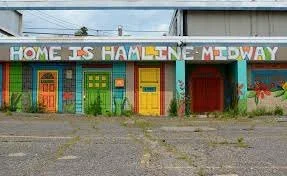Hawona Sullivan Janzen - Love Letters for the Midway
/Hawona Sullivan Janzen - artist, poet, Midway resident
When the story is the message, the medium can move: in poetry or through song; on lawn signs or little scraps of paper; in skywriting. For Hawona Sullivan Janzen, stories often float in on dreams, mooring in her brain as she walks the neighborhood, or waits in her car at a red light.
For this story, “Love Letters for the Midway,” Hawona’s dreams dictated that she compose a poem with words of her neighbors, sprinkled on lawn signs across the Midway neighborhood in St. Paul. Hawona describes the dream that inspired this project: “I was walking, and above people’s houses there were words that looked like skywriting. They were words - I was pretty sure – that I had seen on Facebook posts:
Have you seen my puppy?
Let me tell you about my favorite neighbor
I love pizza
It was all “pretty weird,” says Hawona, a St. Paul-based performance artist. “I thought the dream was odd, quirky,” she admits, and she got on with her day. Later, at a stop light driving through town, she says, “my mind drifted back to that dream.” Later still, while walking, “I saw one of the houses from the dream and thought, ‘Why does this dream keep coming back to me?’ I am supposed to do something with this.”
Re-creating the dream in skywriting seemed ephemeral and cost prohibitive. At that moment, Hawona also recalled a recent comment her mother, who lives in Louisiana, made about a different project Hawona completed outside of St. Paul. “She told me, ‘That project is so beautiful. But I ask you: You do all this work in other communities, what about doing something at home?’”
Midway
Home
Hawona says she was annoyed at first, but her mother “was absolutely right.” “I used to think of the Midway as a passthrough to other places,” Hawona conceded. But her vivid, persistent dream - and her mother - put an end to that. “This is a reminder to myself that this is my place, where my family is, where I eat.”
She reached out to the Hamline-Midway Coalition, her long-time neighborhood’s planning and community organization, and proposed co-writing a grant to celebrate visually what people love – what Hawona loves - about Midway, using residents’, students’, and business owners’ own words. “I’ve got this crazy Hawona idea!” she says. Then she described to the Coalition crowd sourcing a poem that could be divvied up among lawn signs and displayed on residents’ lawns. Printed words to be savored like a love letter, one delicious line at a time.
“Initially,” Hawona admits, “I was not ambitious at all. I thought: six, ten, maybe twenty signs in all. Then I heard the words of my great-great grandmother in my brain. She said, ‘Be BOLD! One hundred signs!’”
The invitation for “Love Letters for the Midway” went out via Facebook and the Hamline-Midway Coalition newsletter and neighbors responded heartily. The Coalition’s then-Executive Director, Kate Mudge, enthusiastically predicted the outpouring, saying “There are more than ten thousand people in this community, surely we can find one hundred people willing to [write a love letter and] host a lawn sign!”
Hawona printed the words and lines out on paper and the cut them into smaller sections to translate them in her storyteller’s mind. “I was trying to get below the surface of what it means to inhabit this community,” she says.
Then the pandemic hit. “That completely changed everything,” Hawona remembers the uncertainty and fear of those early months of spring 2020. “If we are all going to die, what is the point of making art,” she recalls thinking.
Hawona watched the Hamline-Midway Coalition shift into high gear, supporting neighbors and checking in on community. Despite despair and worry and the loss of a dear friend during that time, Hawona doubled down on her art. Her thoughts circled back to the loss of her own son, years before. “I was being confronted by that commitment to myself to put good into the world.” Yet, confusion reigned: isolation was the new normal and people were scared. “I just started to write,” she says of her energy’s arc. “If I couldn’t see how to do it, I should just hang up my clown nose and go home.”
Then George Floyd was murdered by police in Minneapolis. Another terrible blow. The Twin Cities shut down, consumed by shock and grief. A Midway neighborhood pharmacy was burned in the riots and the chaotic aftermath. A Block Club leader knocked on Hawona’s door and told her that white supremacists were gathering at a neighborhood park. “It was a MOMENT in our neighborhood,” Hawona declares. So much was happening; Hawona held the community’s tension alongside her need to make art. “I did NOT want to immortalize [the hatred],” she decided as she considered the “Love Letters” project. “I am about JOY. I wanted to layer it within the conversations my neighbors were having. The difficult moments we faced, the losses. We could have turned away from each other, but people chose not to turn away.”
Hope nudged its way back in. “We could not block off our street and gather like we used to because of Covid,” Hawona says with a shrug. Yet her neighbors created novel ways to be together. “Notes would show up on our doorknobs,” she says, reading from her mind’s eye:
I will be blowing bubbles
if you want to come outside
and blow bubbles too
Hawona’s Midway neighbors were making meaning, performing small acts, and cultivating joy. All around: people were getting sick and dying, violence was erupting. Blowing bubbles eased the tension, invited beauty back to the neighborhood in a tangible way. And the words of the Love Letters kept filtering in. One line arrived:
We are each our own satellite
“Both earth and moon at the same time,” Hawona says smiling, indicating a central metaphor for that moment. “Circling around, trying to keep each other safe, both mentally and physically, in some extraordinary circumstances.” There was more than the death of others and isolation that had been imprinting on Hawona and her Midway neighbors; there was “a death of an old way of being,” she offers, that they simply could not return to.
“Love Letters for the Midway” are emblazoned on sunny yellow lawn signs throughout Midway now, tying the neighborhood together, even though the pandemic and the current racial reckoning have left fissures. The lawn signs will be in people’s yards until 10 January 2022. After that date, the Hamline-Midway Coalition will collect the signs, and keep them safe, until mid-summer when (hopefully) Covid will have downshifted, people can be back outside together, and community can savor the words and phrases composed by them, for each other. Hawona’s vision is to have all one hundred lawn sign poems assembled, in order from one to one hundred, and in a single gathering spot. Follow Facebook and Hamline-Midway Coalition webpage and newsletter to learn when a summer “Love Letters for the Midway” culmination party will be held.
“Poetry as a tool of activism is experiencing a Renaissance,” Hawona says, veritably glowing. Children at nearby Hamline Elementary School are already writing their OWN love letters to the neighborhood. “Choosing to practice love is subversive,” Hawona adds. “Poetry’s epic roots in the telling of a story implies that you are worthy of the story. This is all very powerful, because words are powerful. Remember,” she says:
We circle round on useful things
Love notes have become love tokens
Nobody ever told me poetry was not the answer
Resources:
Love Letters for the Midway: https://www.hamlinemidway.org/lovelettersforthemidway
Hamline-Midway Coalition: https://www.hamlinemidway.org/
Hawona Sullivan Janzen:https://www.facebook.com/HawonaWrites
Photos courtesy of Hawona Sullivan Janzen and Tracy Nordstrom








